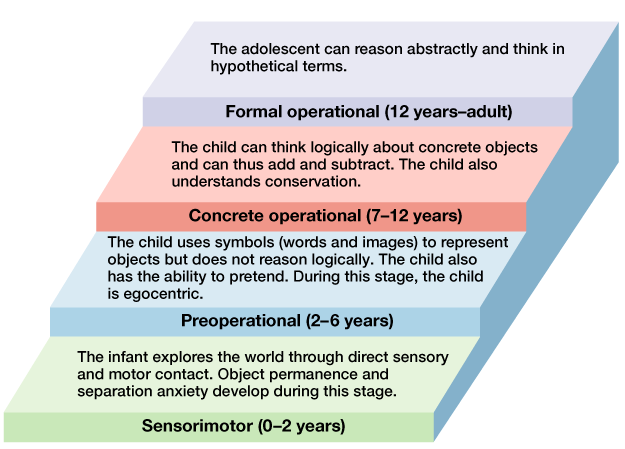Cognitive Development and Changes in the Brain
Adolescence is a time for rapid cognitive development. Cognitive theorist Jean Piaget describes adolescence as the stage of life in which the individual's thoughts start taking more of an abstract form and egocentric thoughts decrease. This allows an individual to think and reason with a wider perspective. This stage of cognitive development, termed by Piaget as the formal operational stage, marks a movement from an ability to think and reason from concrete visible events to an ability to think hypothetically and entertain what-if possibilities about the world. An individual can solve problems through abstract concepts and utilize hypothetical and deductive reasoning. Adolescents use trial and error to solve problems, and the ability to systematically solve a problem in a logical and methodical way emerges.

Piaget's stages of cognitive development
Jean Piaget's theory of cognitive development includes four stages: sensorimotor, pre-operational, concrete operational, and formal operational.
Biological changes in brain structure and connectivity in the brain interact with increased experience, knowledge, and changing social demands to produce rapid cognitive growth. These changes generally begin at puberty or shortly thereafter, and some skills continue to develop as an adolescent ages. Development of executive functions, or cognitive skills that enable the control and coordination of thoughts and behavior, are generally associated with the prefrontal cortex area of the brain. The thoughts, ideas, and concepts developed at this period of life greatly influence one's future life and play a major role in character and personality formation.
Perspectives and Advancements in Adolescent Thinking
There are two perspectives on adolescent thinking: constructivist and information-processing. The constructivist perspective, based on the work of Piaget, takes a quantitative, state-theory approach. This view hypothesizes that adolescents' cognitive improvement is relatively sudden and drastic. The information-processing perspective derives from the study of artificial intelligence and explains cognitive development in terms of the growth of specific components of the overall process of thinking.
Improvements in basic thinking abilities generally occur in five areas during adolescence:
- Attention. Improvements are seen in selective attention (the process by which one focuses on one stimulus while tuning out another), as well as divided attention (the ability to pay attention to two or more stimuli at the same time).
- Memory. Improvements are seen in both working memory and long-term memory.
- Processing Speed. Adolescents think more quickly than children. Processing speed improves sharply between age five and middle adolescence, levels off around age 15, and does not appear to change between late adolescence and adulthood.
- Organization. Adolescents are more aware of their own thought processes and can use mnemonic devices and other strategies to think more efficiently.
- Metacognition. Adolescents can think about thinking itself. This often involves monitoring one's own cognitive activity during the thinking process. Metacognition provides the ability to plan ahead, see the future consequences of an action, and provide alternative explanations of events.
Metacognition and Relativistic Thinking
Metacognition is relevant in social cognition and results in increased introspection, self-consciousness, and intellectualization. Adolescents are much better able to understand that people do not have complete control over their mental activity. Being able to introspect may lead to two forms of egocentrism, or self-focus, in adolescents, which result in two distinct problems in thinking: the imaginary audience (when an adolescent believes everyone is listening to him or her) and the personal fable (which causes adolescents to feel that nothing harmful could ever happen to them). Adolescents reach a stage of social perspective-taking in which they can understand how the thoughts or actions of one person can influence those of another person, even if they personally are not involved.
Adolescents are more likely to engage in relativistic thinking—in other words, they are more likely to question others' assertions and less likely to accept information as absolute truth. Through experience outside the family circle, they learn that rules they were taught as absolute are actually relativistic. They begin to differentiate between rules crafted from common sense (don't touch a hot stove) and those that are based on culturally relative standards (codes of etiquette). This can lead to a period of questioning authority in all domains.
Wisdom and Risk-Taking
Wisdom, or the capacity for insight and judgment that is developed through experience, increases between the ages of 14 and 25, then levels off. Wisdom is not the same as intelligence, and adolescents do not improve substantially on IQ tests since their scores are relative to others in their age group, as everyone matures at approximately the same rate.
Adolescents are more likely to take risks than adults. The behavioral decision-making theory proposes that adolescents and adults both weigh the potential rewards and consequences of an action. However, adolescents seem to give more weight to rewards, particularly social rewards, than do adults.